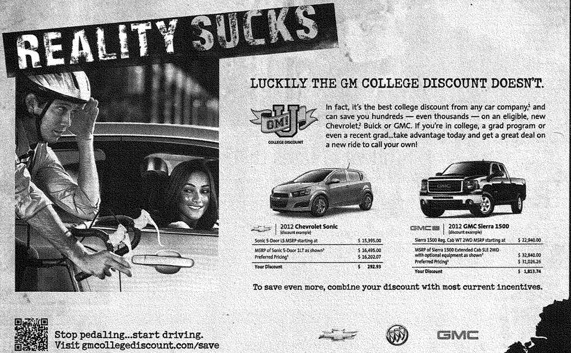UPDATE: Giant Bicycles post an ad that responds to the GM ad. Details on Grist. The ad is displayed below the GM ad here.
While monitoring the "sound and fury" surrounding the recent General Motor's cyclist-bashing ad posted by BikePortland.org, it was heartening to see the downpour of support for cycling and to see it actually affect GM's plans.
Nevertheless, this ad is just the tip of the iceberg. There's been a media blitz of bicycle-bashing for years (this slate.com article talks all about it). Bicycles and cyclists are frequent symbols of emasculation and failure in media. Just in the last 5 years, there's Brad Pitt in Burn After Reading, Steve Carell in 40 Year Old Virgin, Will Ferrell in Everything Must Go and Ben Stiller in Greenberg. Is it GM we're mad at or Madison Avenue and Hollywood?
Furthermore, it seems silly to be shocked that car ads would use sex to promote cars and disparage other modes of transport. Doubly so, given that we just bailed out this particular company from financial ruin and told them to go and compete as best they can. These are the guys who took private jets to D.C. to tell us they were broke. We gave them money anyway. Now we are shocked that these guys don't "get it"?
The real offense is that we somehow elected government representatives that chose to keep this company alive instead of promoting multi-modal transportation. Had we not done that, we would be reaping the benefits of job-creating infrastructure projects and economy-stimulating traffic from pedestrians and cyclists. Instead we're spending our time shouting down tasteless ads for which we paid and ultimately voted while dodging more cars.
Given this industry's track record (GM's in particular), it is doubtful GM learned anything from this. While they are issuing an apology to us, it would not be surprising if they try to get a return on their ad investment by simply retrofitting this ad campaign for some place else in the world where folks don't squawk so much. Ultimately, GM has been and will continue to be an obsolete organization ruthlessly preserving itself and perpetuating an outdated, unsustainable, vision of transportation.
Like Steve Jobs once said, "death is nature's change agent". This ad is a perfect example of what we get when we don't let nature take its course.
Successfully shouting down this stupidity is definitely a sign of progress but it won't really change anything. Only starving the old oil and car lobbies of money will do that. Ironically, that will be tough in the next election given that our next president will either be the guy that saved this miserable company and wants to import oil from Canadian tar sands or a guy from Michigan. Regardless, we can still vote with our feet, our pedals, and our media choices.
While monitoring the "sound and fury" surrounding the recent General Motor's cyclist-bashing ad posted by BikePortland.org, it was heartening to see the downpour of support for cycling and to see it actually affect GM's plans.
Furthermore, it seems silly to be shocked that car ads would use sex to promote cars and disparage other modes of transport. Doubly so, given that we just bailed out this particular company from financial ruin and told them to go and compete as best they can. These are the guys who took private jets to D.C. to tell us they were broke. We gave them money anyway. Now we are shocked that these guys don't "get it"?
The real offense is that we somehow elected government representatives that chose to keep this company alive instead of promoting multi-modal transportation. Had we not done that, we would be reaping the benefits of job-creating infrastructure projects and economy-stimulating traffic from pedestrians and cyclists. Instead we're spending our time shouting down tasteless ads for which we paid and ultimately voted while dodging more cars.
Given this industry's track record (GM's in particular), it is doubtful GM learned anything from this. While they are issuing an apology to us, it would not be surprising if they try to get a return on their ad investment by simply retrofitting this ad campaign for some place else in the world where folks don't squawk so much. Ultimately, GM has been and will continue to be an obsolete organization ruthlessly preserving itself and perpetuating an outdated, unsustainable, vision of transportation.
Like Steve Jobs once said, "death is nature's change agent". This ad is a perfect example of what we get when we don't let nature take its course.
Successfully shouting down this stupidity is definitely a sign of progress but it won't really change anything. Only starving the old oil and car lobbies of money will do that. Ironically, that will be tough in the next election given that our next president will either be the guy that saved this miserable company and wants to import oil from Canadian tar sands or a guy from Michigan. Regardless, we can still vote with our feet, our pedals, and our media choices.
















































